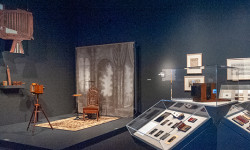[ccfic caption-text format="plaintext"]
By Laura Drinan
Hometown Weekly Reporter
Given momentum by the “Sturm und Drang” movement, the arts were thriving in nineteenth century Germany. Friedrich Schiller wrote the play “William Tell,” and German speakers celebrated the writings of Johann Wolfgang von Goethe. Simultaneously, Ludwig van Beethoven was composing some of his most renowned works.
In the late 1800s, Germany admired the works of artist and printmaker Max Klinger. Nearly 140 years after their creation, a handful of Klinger’s etchings will be on display until June 10 at the Davis Museum at Wellesley College.
The exhibition, named “Intermezzi: The Inventive Fantasies of Max Klinger,” features 12 of Klinger’s pieces, which explore the realistic, yet imaginative compositions that inspired surrealist artists.
Playing off of viewers’ familiarity with German fairy tales and folklore, Klinger depicts an elf hanging off of a tree branch and teasing a bear with thin branch. The bear’s nonthreatening demeanor and the elf’s playfulness produces a jovial and childlike scene to begin the exhibition.
Klinger, however, did create some etchings that were more serious in subject, despite focusing on mythological creatures. He describes the plight of centaurs in his work, showing the creatures’ struggle to survive.
In “Battling Centaurs,” he shows an altercation on a snowy mountainside between two of the creatures, seemingly over a dead rabbit. “Landslide” depicts a family of centaurs journeying through rocky and mountainous terrain, and a young centaur raising a rock to kill a vicious snake.
All of Klinger’s etchings are in black and white, but the amazing detail in each of the plates makes up for its lack of color.
The exhibition groups together scenes from Hans Jakob Christoffel von Grimmelshausen’s novel, “Simplicius Simplicissimus,” which tells the tale of a hermit caring for a naïf named Simplicius.
Klinger’s first plate in this subset exhibits phenomenal detail in the woodsy environment in which the hermit and simpleton live. The hermit’s bony feet and wrinkled sleeves are testament to Klinger’s dedication to detail.
The nineteenth century artist narrates the story of Simplicius through three more plates, which show the hermit’s death, Simplicius’ enlistment in the military, and his eventual seclusion in the wilderness.
The final plate in the exhibition, and perhaps the most fantastical one, is called “Cupid, Death, and the Beyond,” and it depicts just as its title would suggest. On a flat landscape, a bow-wielding cherub and a scythe-wielding skeleton ride a bicycle-coffin hybrid as ghost-like creatures chase them.
Presenting a compelling blend of realism and romanticism, Max Klinger’s prints certainly warrant a trip to the Davis Museum.






















